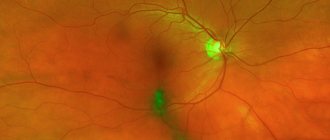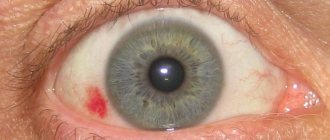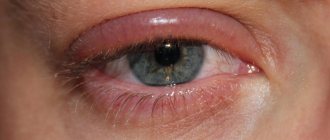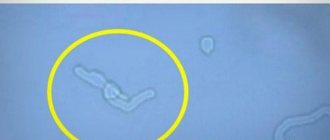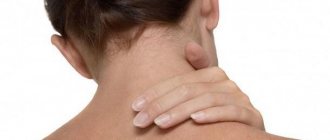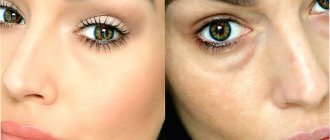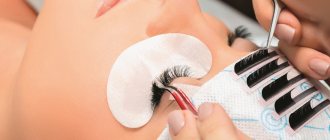The defect often develops in adolescence and young adulthood. The predisposition to the formation of pathology is greater in males.
Milia (sometimes called retention cysts) are small white dots under the eyes or other localization that form under the skin in the form of dense white-yellow nodules with clear boundaries. Dimensions can vary from 0.5 to 3-4 mm.
The points are formed in non-connecting clusters, less often - individually. Because of this, the skin becomes dense and rough, with many furrows that separate these nodules from each other. Usually the pathology goes away on its own, which is explained by a change in the skin epithelium. However, there is a possibility that the healing process will take several years.
Causes
White spots near the eyes can appear as a result of many reasons. It is believed that a white dot is formed due to clogging of the sebaceous gland, as a result of which it enlarges, expands and accumulates sebaceous clots that come out after squeezing out. However, it is not.
It has been scientifically proven that retention cysts are not associated with the sebaceous and sweat glands. Their capsule is filled with accumulations of keratin, rather than sebaceous gland secretions. Keratin is a dense substance, so no matter how hard you try to remove these points, squeezing out is unlikely to be successful. Occasionally, when the nodule is pierced, a little soft secretion may be released.
The main reasons for the development of nodules are:
- Increased release of keratin as a result of rapid division in the upper layers of the skin and its exfoliation.
- Hereditary factor.
- Hormonal disorders, pathology of endocrine organs. Often occurs in teenagers.
- Metabolic changes.
- Nutritional factor – consumption of junk food.
- Hypovitaminosis and avitaminosis.
- The influence of cosmetics.
- Due to a lack of vitamin A, the harmful effects of solar radiation increase.
- Cardiovascular pathology.
- Diseases of the gastrointestinal tract.
How to Get Rid of Whiteheads and Dots Under Eyes Fast Home Treatment Methods for Whiteheads
Treatment options vary depending on the underlying cause of their occurrence and the factors influencing their occurrence. Here are numerous examples of cures that you can add to your treatment regimen:
Treatment of white spots under the eyes in children is not recommended. Try to maintain the necessary hygiene for the child and just wait until the skin itself eliminates such inflammations with the help of its regenerative functions.
For adult bumps, it is recommended to use a cleanser with salicylic acid.
You should also avoid using cosmetics on the eyelids and around the eyes in the form of creams and eye shadows until the bruises have been healed and the presence of whiteheads in the areas where such cosmetics are applied has been eliminated.
Applying a retinol cream may also help. However, do not use retinoid creams on the upper eyelid.
Your eyelids and eye area will benefit greatly from whitehead treatments such as microdermabrasion, chemical peels, and laser therapy. Surgical removal is also a common option for removing such skin reactions.
As for the chalazion, applying a warm compress may help. Immerse a napkin in warm water, lightly squeeze out the excess liquid and place it on the chalazion until it cools, do this several times a day.
White milia under the eyelids and eyes
Is it possible to remove them yourself?
After you have been diagnosed with this pathology, a logical question arises - how to remove white spots under the eyes? This can be done either in a specialized salon or at home. However, performing the procedure at home can lead to an infectious process. Therefore, it is better to go to a clinic where all sanitary and epidemiological standards are observed. Another advantage of going to a medical institution is the speed of obtaining results and its sustainability.
Removing white spots under the eyes
Possible options for removing whiteheads under the eyes include laser therapy, chemical peels, microdermabrasion, and surgical removal. Topical retinoid creams and gels can also be used to get rid of milia and whiteheads under the eyes.
If milia do not improve with regular treatment with gels or creams for about a month or so, then they most likely do not respond to the above interventions and you should consult a dermatologist about the possibility of removing whiteheads through surgery or cosmetic surgery.
Milia and whiteheads are common rashes. Quite a lot of people go to a beauty salon to provide services for their removal or prescribe treatment methods, based on a monthly course of treatment with ointments or remedies against such rashes. The course of such treatment is completely painless and quite simple to treat.
The most typical location for milia breakouts is on the face, usually on the skin around the eyes or on your cheeks, but can appear almost anywhere on the entire body.
There was a time when my body had inflammation of white spots on my shoulders, when my skin reacted this way to tanning. I simply forgot to use sunscreen while on vacation. As a result, my skin not only turned red. I felt a burning sensation, and subsequently milia rashes appeared on my shoulders. in the form of white dots.
Left untreated, milia may go away on their own. However, you can easily get rid of them using a few products that you probably already have in your bathroom cabinet. It is important to be patient when starting treatment to see the whitehead removal process through to completion. But if you have been regularly doing home remedies to treat them for a month without any results, you better schedule an appointment with a dermatologist.
Removal methods
White spots near the eyes can be removed using several methods. Some cosmetics stimulate the spontaneous release of milia from nodules. These drugs include urea-containing agents and salicylic acid derivatives. However, their effect is insignificant.
Let's look at more effective methods that are used in clinics.
Mechanical method
First, the cosmetologist cleanses the skin of cosmetics, then steams it. In this way, the expansion of the pores is achieved, which greatly facilitates the release of contents from their cavity. Next, the specialist punctures the white dot using a sterile game and removes the contents with fingers wrapped in a sterile gauze cloth. After the procedure, an antiseptic solution is applied to the wound surface. This provides antiseptic conditions in the wound area. There is no infectious process or inflammatory reaction.
Electrocoagulation
The method is based on the effect of electric current on the area of the pathological process. The electrocoagulator has a hot loop that interacts with the layers of the skin. The result is cauterization of the wound and the formation of a dense crust, which peels off on its own and leaves no traces. It is only necessary to treat the surface of the wound with an antiseptic solution, for example, chlorhexidine.
The advantage of the method is the ability to locally influence deeply located milia without damaging nearby tissues. There are also disadvantages - the procedure is painful. Therefore, local anesthetics are used.
Laser
The method is similar to the use of an electrocoagulant and is considered the most effective way to remove large numbers of nodular clusters of whiteheads around the eyes. It is also used when other procedures are difficult to access and impossible to perform.
For therapy, a CO2 laser is most often used, which allows for high-precision layer-by-layer destruction of pathological elements on the skin, without causing any damaging effects on the healthy areas around them.
Advantages of the method:
- Bactericidal type of effect on microbial flora.
- “Soldering” of capillaries and small vessels in the affected area, preventing bleeding.
- The ability to visually monitor the progress of therapy and quickly make adjustments.
- Effective end result.
Treatment methods
If clear spots appear around the eyes, it is recommended to consult a cosmetologist or dermatologist. The specialist will prescribe the most effective method of treatment, which could be a course of medication or removal of small lumps. For small amounts of milia, alternative remedies approved by your doctor may be used.
Folk recipes
Alternative medicine suggests treating small white pimples with:
- Aloe.
- Propolis.
- Viburnum juice.
- Onions with honey.
Several fresh aloe leaves will need to be washed well, squeezed out the juice and mixed with a small amount of alcohol. Use the resulting mixture to wipe the pimples before going to bed.
A small piece of propolis is ground and poured with sunflower oil. The composition must be kept for 3 days in a cool place, then the milia should be treated once a day (in the morning).
The juice of viburnum berries is combined with oatmeal. The white dots are covered with the mixture. When the composition dries, wash with cool water.
The peeled onion is coated with honey and baked in the oven for half an hour (at a temperature of 100 °C). Next, it must be crushed and applied to pathological areas in the mornings and evenings.
Traditional treatment of millet takes a long time. It often takes a month or more for the white bumps to disappear.
Medications
Popular medications that help in the fight against white pimples under the eyes include:
- Boric alcohol.
- Lipobase, Emolium (creams containing urea).
- Salicylic alcohol.
The listed drugs are used for local treatment of milia. The frequency of application of each product should be agreed with the attending physician.
In addition to the products mentioned, peelings can be used. It is recommended to purchase them at a pharmacy. If there are seals around the eyes, formulations with small granules should be used.
Millet is a pathology prone to periodic relapses. If folk remedies or medications do not bring positive results, and the white pimples appear again, you should resort to their removal with the participation of a doctor.
Will traditional methods help?
You can try to remove whiteheads yourself, but preference should be given to highly qualified therapy, since the likelihood of introducing an infection at home is extremely high. This will lead to inflamed pimples. Such acne leaves behind numerous ulcerations, scars, and spots.
Home treatment takes longer and is less effective, but people still use this method.
There are several main stages of home therapy:
- Facial cleansing.
- Steaming the skin.
- Exposure to special infusions and tinctures (mother and stepmother, Kalanchoe), the use of ointments (onion with honey or propolis), various masks (for example, paraffin).
In general, the listed stages coincide with the preparation for the mechanical method of influence. The only differences are the substances used to treat the pathology.
Ways to get rid of whiteheads
So, there are several ways to remove it:
- Flash peeling is applicable if white spots are located very close to the surface of the skin.
- Mechanical removal of millet is carried out on previously cleaned and disinfected skin, with a sterile needle, the cosmetologist, piercing a point in the center, squeezes out the contents with hands in sterile gloves. If you are an experienced cosmetologist, then your skin will not be damaged and all “troubles” will be removed.
This method has its pros and cons. Of course, the advantage is the low cost of the procedure, but at the same time, mechanical removal is not suitable for people with thin or overly sensitive skin. Another disadvantage of this method is that in one procedure it is possible to remove only 10-15 milia, after which a break of several days is taken. Treatment can take quite a long time. Also, the mechanical method is not suitable if the white dots are located on the eyelids very close to the roots of the eyelashes. The skin in this area is extremely delicate, and exposure to it with a needle is undesirable, in addition, noticeable redness will remain
- Electrocoagulation is performed by a cosmetologist. With the help of a small current supplied through the needle of an electrocoagulator, the affected area of the skin is affected, on each nodule separately. The procedure is painless, the marks after cauterization disappear after some time.
This procedure has much greater advantages compared to the second method. Using electrocoagulation, you can get rid of fairly deep formations, which is difficult to do with a needle or curette. But this method has its own characteristics: after cauterization, a dense crust forms at the site of the milium, which must be treated for 10 days until it falls off. Also, shallow scars may remain at the spots - small, but still noticeable.
- And laser removal , the most effective and safe, painless, scars disappear after 10-14 days.
It is suitable for large clusters of points, as well as when they are located too close to the organs of vision. To carry out the procedure, a CO-2 (carbon dioxide) laser is used, which has been successfully used in aesthetic cosmetology for almost three decades. It eliminates pathological formations layer by layer through thermal action. After its use, there is a lack of redness and suppuration, which can be observed in the case of a mechanical procedure, since the laser beam also has a bactericidal effect. In one or two procedures you can completely get rid of milia. Laser coagulation has the highest cost among the described types of treatment.
Prevention
Preventing the appearance of white spots on the eyelid or under the eye is achieved by constant skin care. Using quality cosmetics reduces the risk of milia. In the summer, you should refrain from using greasy creams; you should remove cosmetics from your face with a non-greasy product.
You can also use a paraffin mask and exfoliate your face with a brush. Eating vegetables and fruits, healthy foods that do not contain large amounts of fats and carbohydrates helps keep the skin in good condition.
The appearance of white spots on the skin occurs for various reasons. Therefore, you should contact a specialist rather than try to eliminate the pathology yourself. Mechanical removal at home can lead to various infectious processes. Treatment at the clinic will be fast, effective and safe.
Author: Andrey Akimov, doctor, especially for Okulist.pro
Causes of white spots under eyes
They can occur spontaneously, or after certain injuries as white retaining follicular cysts, caused by blockage of small hairy units (hair follicle). Surgical removal of such inflammations in a cosmetology office is the only correct choice for treating such points.
Such skin rashes are a purely cosmetic problem and a person has the right to choose for himself - to treat and get rid of such rashes, or to wait for the natural process of skin regeneration and healing from the inside.
Advice from an expert
Dr. Tatyana Shapovalenko, host of the program “About the Most Important Thing.”
– Whiteheads occur due to the active work of the sebaceous glands. They usually appear after excessive sunbathing, smoking, and hormonal imbalances. It is better to get rid of whiteheads with the help of a dermatologist. If you squeeze out the “millet” yourself, a large red scar may form. The doctor may prescribe medication, laser therapy, curettage (a mechanical method of disposal) or electrocoagulation.
And most importantly, you can prevent the appearance of whiteheads by carefully caring for yourself beautiful inside and out.
Red spots under the eyes of a child: what to do?
However, it is not always only adults who can observe red dots above their eyelids and under their eyes. If red dots appear under a child’s eyes, this situation can also signal allergies and diseases of internal organs. It is important to immediately show your baby to a doctor.
Small red dots under a child’s eyes can appear en masse or in isolated cases. Often parents of children under one year old face this problem. In this case, red dots under the eyes of a child may be an allergic manifestation to heat (urticaria), soap, cream, or sun. In this case, the red dots that appear under the child’s eyes are only a temporary unpleasant phenomenon.
Only a pediatrician or dermatologist can examine red dots under a child’s eyes; only an experienced doctor can determine the causes, who will have to prescribe adequate treatment. You should not remove red dots under your child’s eyes on your own!

